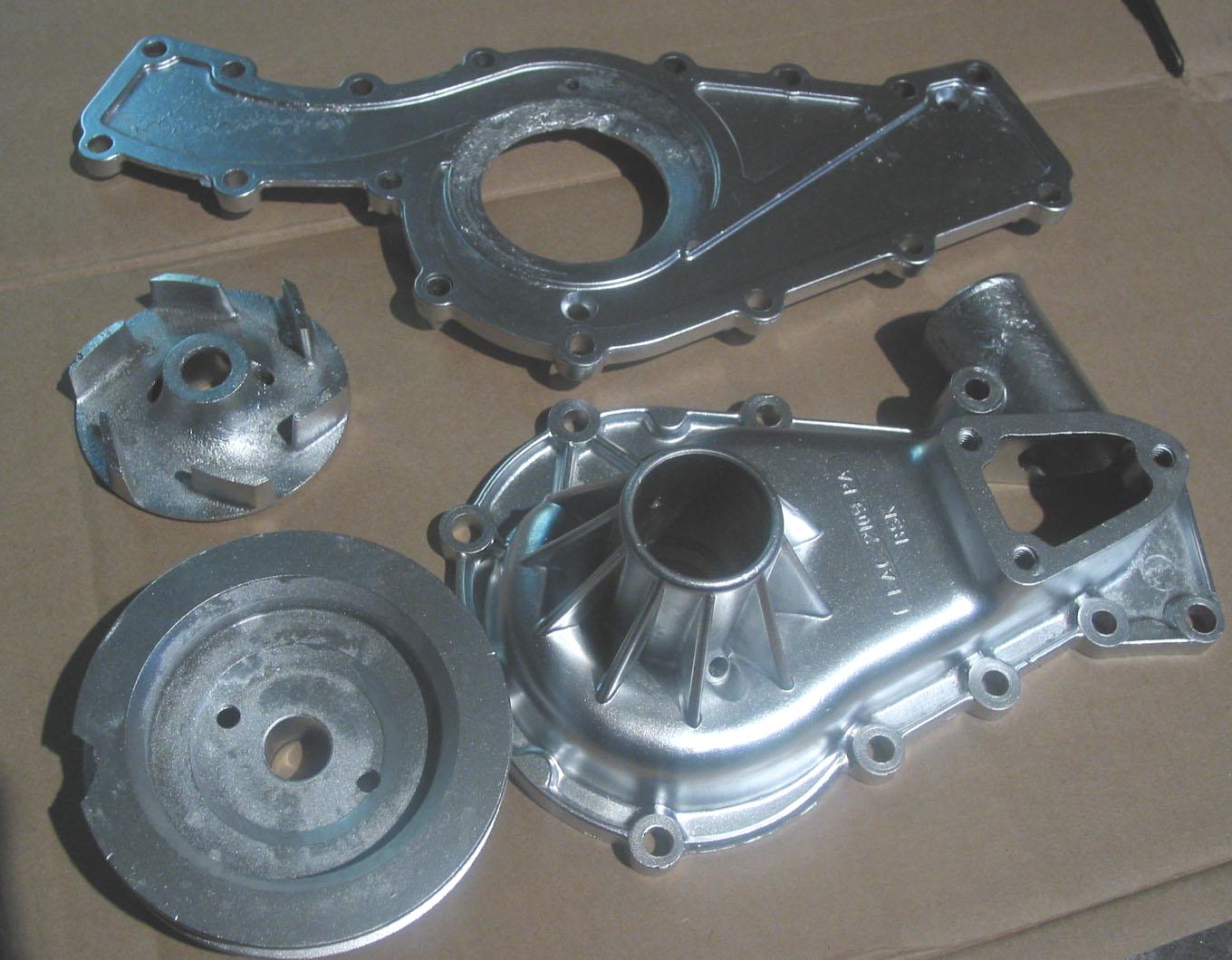| |||||||||||
| |||||||||||
JAGUAR V12 WATER PUMPThe Jaguar V12 water pump usually seems to work well enough. Kirby Palm, however, broke his impeller while rebuilding his, and instead of getting a Jaguar replacement, put a Chevy impeller in. The Chevy impeller fit perfectly and worked fine, but it didn't look similar at all; its vanes were nearly radial, and there were more of them. Ever since then, there has been much discussion online about why they are different and what the implications of the designs are. Of course, it would be nice to have a picture of a genuine Jaguar impeller so everyone could see what it looks like. Richard Dowling provided this picture. I have posted it full-size rather than making it smaller, because detail is important here.  Why do the parts look like they've been painted silver? "Because they are painted silver. An old trick, spray with silver paint, cheaper the better since it is easier to clean off later. Gives much better definition and highlights for 'photos." Descriptions: The housing at the bottom right is made of aluminum and holds the bearing and the seal. While the bearing is very similar to those simply pressed into cast iron water pumps in other cars, here besides being pressed in there is a setscrew in the top to ensure the bearing doesn't turn in the aluminum housing. The hole for the setscrew is barely visible in this picture. The weep hole clearly visible below the bearing between the stiffening ribs should never have coolant coming out of it; if it does, the seal is shot. The triangular hole to the right is the inlet; there is a separate elbow that bolts on here that provides the lower radiator hose connection as well as the boss for the fan switch. The hose connection sticking out the top is the bypass inlet, which means it receives coolant directly from the thermostat housings via the crossover pipe. The part at lower left is the pulley. It's made of iron and presses onto the shaft. No, it's not supposed to have a notch in it. The part at center left is the cast iron impeller. This one appears to be in good order. There are two threaded holes for using a puller to get it off without breaking it. The appearance of the vanes themselves seems to be somewhat unusual among automotive water pumps; there are only six vanes and they are extremely backward-inclined. Most water pumps, including the Chevy part that Palm installed, have vanes that are either nearly radial or only somewhat backward-inclined, and they have more of them. The part at the top of the picture is an aluminum plate that separates the inlet chamber from the outlet chamber, and it also forms a cover for the passages to each bank. From its position in this picture, it needs to be flipped upside down before the housing is bolted to it. After the housing is attached, the impeller is pressed onto the shaft, so the impeller ends up on the exterior of this assembly and the tips of the impeller vanes are positioned very close to the area surrounding the center inlet hole. Dowling: "Note this 1985 H.E. engine, reputedly with 45,000km on the clock, has a fair bit of erosion around the impeller inlet area of the alloy cover plate. It was not a well maintained car I suspect." "Fair bit" is an understatement; if this engine really has only 45,000km on it, that much erosion is alarming. The final assembly of the water pump occurs as it is bolted to the front of the timing cover, because the timing cover serves as the rear cover of the pump and the other half of each passage to the banks. |
|
| ||
 |
Improve your Jag-lovers experience with the Mozilla FireFox Browser!
©Jag-loversTM Ltd / JagWEBTM 1993 - 2024 All rights reserved. Jag-lovers is supported by JagWEBTM For Terms of Use and General Rules see our Disclaimer Use of the Jag-lovers logo or trademark name on sites other than Jag-lovers itself in a manner implying endorsement of commercial activities whatsoever is prohibited. Sections of this Web Site may publish members and visitors comments, opinion and photographs/images - Jag-lovers Ltd does not assume or have any responsibility or any liability for members comments or opinions, nor does it claim ownership or copyright of any material that belongs to the original poster including images. The word 'Jaguar' and the leaping cat device, whether used separately or in combination, are registered trademarks and are the property of Jaguar Cars, England. Some images may also be © Jaguar Cars. Mirroring or downloading of this site or the publication of material or any extracts therefrom in original or altered form from these pages onto other sites (including reproduction by any other Jaguar enthusiast sites) without express permission violates Jag-lovers Ltd copyright and is prohibited |
 |